BY LESA.LORUSSO ON MAY 31, 2012 IN FLORIDA HISTORICAL SOCIETY
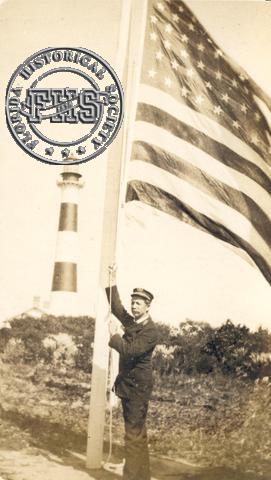

Photos of Cape Canaveral Lighthouse provided courtesy of the Florida Historical Society. Image left: Capt Clinton Honeywell, Image right: view of rocket launch.
In honor of Memorial Day this week, it is fitting to review a shining example of historic preservation that holds both US government and military importance. The Cape Canaveral Lighthouse is a well-restored beacon that has served seafarers and astronauts alike for over 140 years. Located presently on the property of the Cape Canaveral Air Force Station in Brevard County, Florida the Cape Canaveral Lighthouse is a beautiful symbol of our nation’s proud history. The lighthouse itself has witnessed American history unfold as it has endured Seminole Indian threats, impending Yankee invasion during the US Civil War and viewed pivotal rocket launches during the genesis of the US space program.
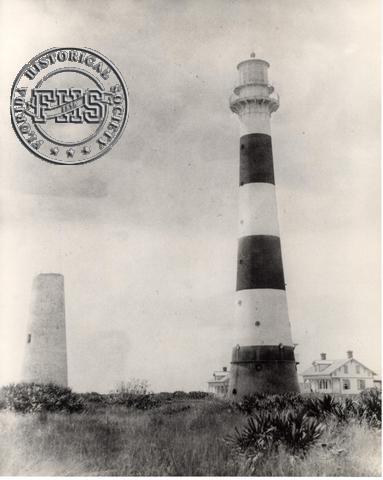 The original Canaveral Lighthouse was built in 1848 and was a brick structure only 65 feet tall seen in this image to the left of the newer and much taller lighthouse(2). Its light was produced by a set of fifteen lamps backed by 21-inch reflectors. Nathanial Scobie was the light’s first keeper, but he soon abandoned his position due to the threat of a Seminole Indian attack (1). The first lighthouse was built to warn mariners of shoals, or dangerous rocks extending eastward from the cape, but soon garnered criticism from sailors. Its diminutive size may have played a part in its inefficiency but whatever the cause, one sea captain remarked that “the lights on Hatteras, Lookout, Canaveral and Cape Florida, if not improved, had better be dispensed with, as the navigator is apt to run ashore looking for them (1).” Contending with growing concerns of mariners, the US government approved construction of a new tower in 1860, but plans were delayed with the outbreak of the US Civil War the following year.
The original Canaveral Lighthouse was built in 1848 and was a brick structure only 65 feet tall seen in this image to the left of the newer and much taller lighthouse(2). Its light was produced by a set of fifteen lamps backed by 21-inch reflectors. Nathanial Scobie was the light’s first keeper, but he soon abandoned his position due to the threat of a Seminole Indian attack (1). The first lighthouse was built to warn mariners of shoals, or dangerous rocks extending eastward from the cape, but soon garnered criticism from sailors. Its diminutive size may have played a part in its inefficiency but whatever the cause, one sea captain remarked that “the lights on Hatteras, Lookout, Canaveral and Cape Florida, if not improved, had better be dispensed with, as the navigator is apt to run ashore looking for them (1).” Contending with growing concerns of mariners, the US government approved construction of a new tower in 1860, but plans were delayed with the outbreak of the US Civil War the following year.
After the Civil War ended the construction began on the second Cape Canaveral Lighthouse only 80-90 feet from the first brick tower and was completed in 1868 (2). The new lighthouse seen in this image to the right of the old tower is 151 feet tall and its beam shines 22 nautical miles (3). The first three levels of the new tower were designed as living quarters and consisted of a kitchen, living room, and bedrooms. The exterior staircase at the base of the tower allowed a keeper, or person assigned to maintain and operate the lighthouse, to access the top of the tower without having to go through the living area. Today there is a door at the ground level facing the oil house, which is a small brick building used to store kerosene used in lighting the beacon. This door was not original and was added in the 1930’s for the keepers’ convenience. Originally painted white, the Cape Canaveral Lighthouse didn’t receive the distinctive black bands that are seen today until 1873.
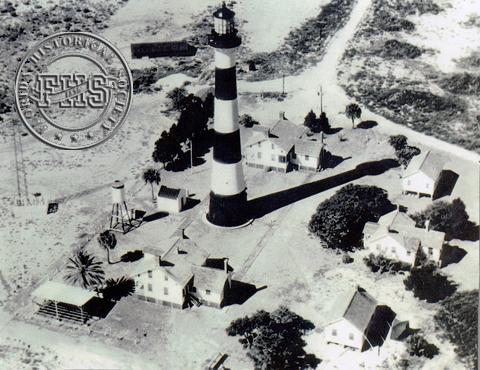
Image provided courtesy of the Florida Historical Society. Aerial photo of relocated lighthouse and keeper dwellings.
On May 10, 1868, the first-order Fresnel lens, which filled the lantern room atop the 160-foot tower, was lit for the first time (1). French physicist Augustin Fresnel developed the Fresnel lens used in the Cape Canaveral lighthouse in 1822. The beautifully complex invention is a built-up annular lens made up of a central spherical lens surrounded by rings of glass prisms. The central portions of these prisms refract and the outer portions reflect and refract the light. A canvas drape was used inside the gallery windows during the daytime to protect the fragile lens from the strong Floridian sun cracking the prisms. Just before dusk the drape was brought down and the light was lit (3).

Image provided courtesy of the Cape Canaveral Lighthouse Foundation
In the 1890’s threatening beach erosion required that the lighthouse be torn down and moved to its current location, about a mile inland (2). The cast iron structure with a brick lining disassembled and over a period of ten months, the tower was transported inland using a rail cart pulled by mules and roman numerals were used on the interior of the structure to help in putting the iron pieces back together (3). The light was relit at its new location on July 25, 1894. The smaller, original lighthouse was blown up and used as fill material at the new site. The place where the two lighthouses stood incidentally was never lost to the sea and still stands about 400 feet from the ocean (1). In 1939 the Coast Guard took over the operation of the lighthouse, which was automated in 1967 and continues to serve as an active lighthouse. In 1993, the first-order Fresnel lens was removed from the tower. The strong vibrations from the frequent launches that began in the 1950’s were starting to destroy the exquisite lens. Several prisms had in fact fallen out of the supporting brass framework by the time the priceless lens was restored in 1995. It is now on display at the Ayres Davies Lens Exhibit Building at the Ponce de Leon Inlet Lighthouse in Ponce Inlet, FL (1).
Although the Cape Canaveral Lighthouse was originally designed to house its attendants, living inside the metal tower during the hot and humid summer Floridian months without air conditioning must have been similar to living in an oven. The keepers soon abandoned the tower’s living area in favor of their own dwellings outside the tower and in 1876, $12,000 was given by the US government for the construction of white washed Florida vernacular dwellings for the keepers and their families (1). These dwellings housed keepers that included the Burnham, Wilson and Honeywell families and were eventually demolished in 1967 (1).
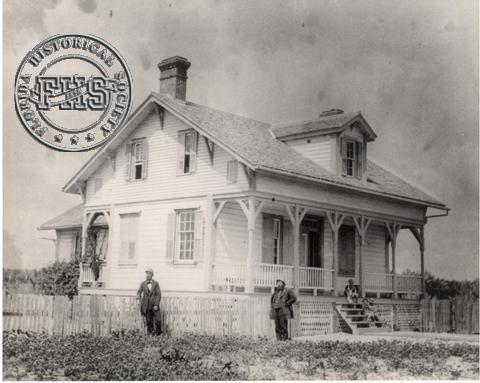
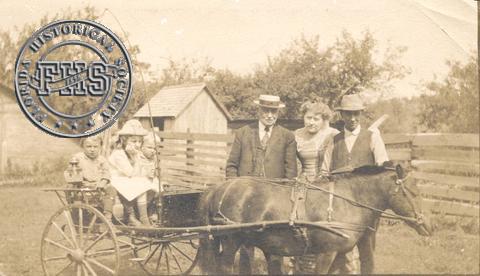
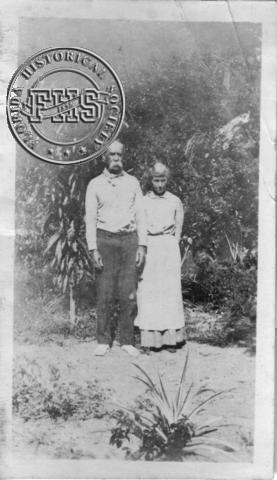
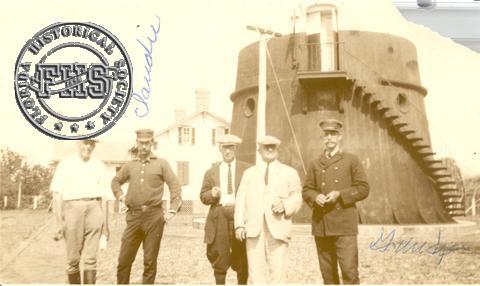
Above photos provided courtesy of the Florida Historical Society. Top image: Keeper dwelling, middle left: Robert Burns Honeywell at center, middle right: Assistant Keeper George and Anna Quarterman, lower image: Keepers Floyd Quarterman, Clinton Honeywell.
Renovations to the Cape Canaveral lighthouse are ongoing. The Coast Guard started to conduct a thorough restoration of the lighthouse in late 1995. A canvas shroud was placed over a network of nylon lines strung from the lighthouse to protect the surrounding area while the lead-based paint was removed from the tower. As part of the restoration, a new lantern room was placed atop the lighthouse and the original was placed on display at the Air Force Space and Missile Museum (1).
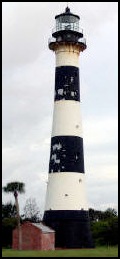
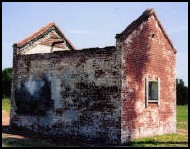

Images provided courtesy of he Cape Canaveral Lighthouse Foundation. Left: Paint restoration, middle: oil house restoration, right: re-installation of lantern room.
The lighthouse became property of the U.S. Air Force in December of 2000. The oil house, which lost its roof in a violent windstorm in the 1970s, was restored in 2003. The re-installation of the lantern room in February of 2007, capped off a nearly million-dollar, yearlong renovation of the lighthouse, and the beacon in the lantern room was relit on Sunday, 29 April 2007. The beacon is supported by the Cape Canaveral Lighthouse Foundation, which hosts public events on the grounds each year. Recent grants awarded to the Cape Canaveral Lighthouse Foundation include a grant from the Florida Lighthouse Association in October 2011. This award will fund a shell and river rock walkway from the parking lot to the oil storage facility and the lighthouse. The use of crushed shell and river rocks are indigenous to the Cape and were used during the lighthouse keeper’s era.
A video tour of the Cape Canaveral Lighthouse conducted by Dr. Sonny Witt can be viewed on YouTube. View the Lighthouse tour.
- http://www.lighthousefriends.com/light.asp?ID=364
- Field, A. Clyde, Harrell, George Leland, Parrish, Ada Edmiston. Images of America Central Brevard County Florida. Arcadia Publishing. Great Britain, 2004.
- http://canaverallight.org/
UPDATED Tue, 9 Jul 2019
FHS received an email from Gerry & Shelley P. that the above May 2012 blog had outdated information about current tours and links which was removed. The following update was provided by Gerry and Shelley:
The Cape Canaveral Lighthouse Foundation is the organization to contact in regards with visiting and touring the facilities. Previous tour operators and schedules have changed and are no longer valid.
Please link the Cape Canaveral Lighthouse Foundation website at:
You may also find updated and detailed information about availability to tour the facilities and the current renovations that are happening at the Cape Canaveral Lighthouse on their website.
The phone number you have listed is incorrect. The correct phone number is:
321-307-2900
Hours are Tuesday thru Friday 8:30am to 12:30pm and Saturday 9am to 1pm
Thanks for supporting the lighthouse!